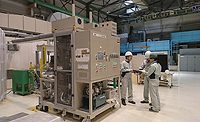The three factors include the change in presidential administration, the faltering economy and the events and aftermath of the Sept. 11 terrorist attacks.
"The effects of these are not simply isolated and cumulative," said Dr. Jules Duga, a Battelle senior researcher and coauthor of the report. "It is clear that there are interactions among the three, and -- when superimposed upon what one might consider a 'normal' set of circumstances of change -- their effects are somewhat more difficult to deal with."
Highlights from the forecast are:
The impact of significant external forces cannot be underestimated. "In previous years, the analysis of the emerging patterns of R&D could readily accommodate almost any singular disruption and could present a reasonable picture of the anticipated effects," Duga said. "However, the concurrent triple whammy . . . creates a degree of uncertainty that is higher than usual and adds a layer of complexity to the forecast."
The Federal Outlook
Government commitment to R&D before Sept. 11 was beginning to show signs of growth driven largely by proposed expansions of programs in defense and health. As a result of Sept. 11 events, federal expenditures on R&D will be even greater, especially in the areas of intelligence information and improved methods for the interpretation of such information. Other areas include electronics for computers and telecommunications, and pharmaceuticals and medical-delivery systems using specialized capabilities in vaccine development and administration.The Industrial Outlook
While the total amount is significant, the rate of increase is somewhat less than has been experienced in recent years. The economic downturn will have an adverse effect upon both the funding of R&D and the distribution of that funding across different performing sectors. Historically, inflation-adjusted reductions in R&D funding have resulted in periods of retrenchment that lasted over a few years. However, this year's change in industrial support is primarily a change in the rate of growth, and a period of adjustment.Battelle, Columbus, Ohio, serves industry and government in the areas of technology development, laboratory management and technology commercialization. For more information, call Media Relations Manager Katy Delaney at 614-424-5544, or e-mail delaneyk@battelle.org. Reprints of the full report can be obtained by calling Karen Taylor at Battelle, 614-424-5545, or by e-mail at taylorks@battelle.org.

